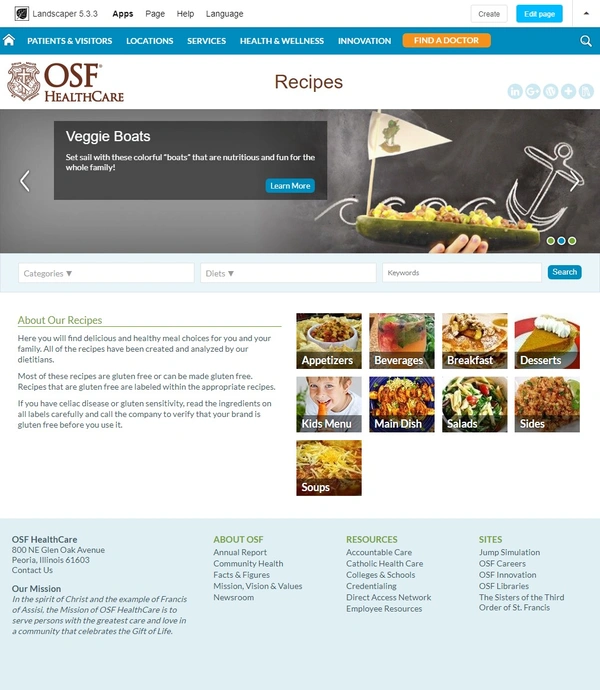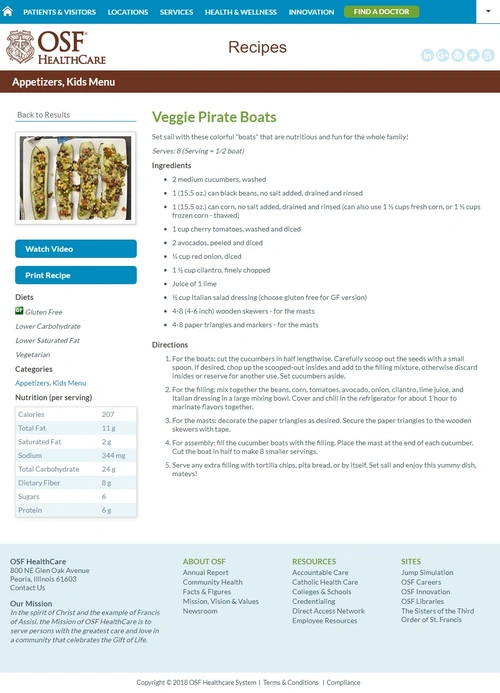Imaginary Landscape: A Chicago Website Design Company for Healthcare
Recently updated on
When a patient lands on your website, they're not looking for design trends or clever copy—they're looking for care.
Whether it's a mother trying to schedule a pediatric visit after hours, a senior searching for pre-operative instructions, or a new resident looking up your ER wait times, your website serves as the vital connection between your organization and those who need your services the most. And in healthcare, that bridge can't afford to be weak.
Yet many hospital websites underperform—not because of a lack of effort, but because they weren't built for the complexity, compliance, and patient expectations that define modern healthcare. From clunky user experiences to inaccessible content, digital shortcomings can result in missed appointments, frustrated patients, and lost trust.
Medical jargon often adds an unnecessary layer of complexity to the user experience. As highlighted in this blog post, the recommended reading level for online content is sixth grade. If your site navigation uses terms like “pediatric oncology” while patients are searching for “childhood cancer,” you're not just being clinical—you're creating friction. A site that confuses rather than guides isn't just ineffective—it's inaccessible.
These are the challenges a professional, healthcare-savvy design partner can solve.
Why Hospitals Need More Than a Good-Looking Website
A hospital's website is a core operational tool. It must deliver accurate, timely, and accessible information while ensuring security and compliance with relevant regulations. Today's healthcare organizations require digital platforms that:
- Support HIPAA and ADA compliance
- Offer multilingual and mobile-first user experiences.
- Integrate with Electronic Health Record (EHR) systems, scheduling tools, and patient portals.
- Organize complex service lines and departments into an intuitive navigation hierarchy.
- Protect sensitive data from cybersecurity threats.
When websites lack these essentials, the costs aren’t abstract. Patients may abandon their care journey if the site is slow, hard to navigate, or outdated. Missed appointments increase the administrative burden. Unsecured data opens the door to reputational and legal risk.
It’s no surprise that $100,000 for high-quality website projects is a standard industry investment. Done right, a website becomes more than a marketing asset—it becomes infrastructure.
Conversely, what begins as a $20-a-month fix can quickly spiral into thousands of dollars in losses if the platform can’t rank in search, drive patient engagement, or scale with your services. Worse still, those inefficiencies often surface only after reputational damage has already occurred.
The Value of a Chicago Website Design Company—Wherever You're Located
Partnering with a Chicago-based website design company such as Imaginary Landscape provides access to in-depth healthcare expertise and technical precision, regardless of your location. While our roots are in Chicago, we support hospitals, clinics, and health systems across the Midwest and nationwide.
Here's what you get when you work with a healthcare-specialized firm like ours:
- Compliance-first development – HIPAA, WCAG, and security considerations baked into every phase
- Custom UX/UI – Interfaces designed for real-world patients and families, not generic users
- Mobile-first, multilingual design – Serve diverse communities with clarity
- Structured service navigation – Support for large, multi-specialty systems
- SEO and content architecture – Help users and search engines find what matters
- Ongoing support – Security, uptime, updates, and enhancements post-launch
Chicago's tech and healthcare ecosystem offers a unique advantage—access to forward-thinking digital talent and proximity to world-class health systems. Even if your hospital isn't in Illinois, the experience and best practices gained here translate seamlessly to healthcare institutions anywhere.
A professional firm isn't just a vendor—it's a strategic partner that understands the language of compliance, the pace of healthcare, and the expectations of patients.

What Hospitals Risk Without the Right Web Partner
Choosing the wrong website partner—or relying on underpowered tools—can lead to:
- Regulatory violations – Failing to meet HIPAA or WCAG standards may result in audits or legal exposure.
- Eroded patient trust – Inconsistent branding, unclear information, or outdated interfaces signal a lack of professionalism.
- Operational inefficiencies – Poor integrations force staff to juggle multiple systems, adding friction to patient workflows that are manually managed.
- Missed digital growth – Lack of SEO strategy, analytics, or scalable structure limits future marketing and service expansion.
In healthcare, your website must do more than "work"—it must support your mission. A site that frustrates, confuses, or misrepresents your care model doesn't just underperform—it undermines your brand.
Content Strategy: A Key to Patient Engagement
Even the most beautifully designed healthcare website can fall short if the content doesn't connect. A strategic content approach ensures that patients not only find the correct information but also understand it.
According to Health Literacy Online, a guide published by the U.S. Department of Health and Human Services, nearly 9 out of 10 adults struggle to understand and use everyday health information. For hospitals, this means that medical terms, lengthy paragraphs, and overly clinical navigation can create serious barriers.
When a patient visits your site under stress, seeking answers about symptoms, care options, or next steps, they don’t need jargon. They need clarity, reassurance, and direction.
That’s why our process emphasizes:
- Plain-language writing that meets federal health literacy standards
- Patient-centered labeling (e.g., “Heart Doctor” instead of “Cardiology Department”)
- Organized, scannable layouts that reduce cognitive overload
- Clear calls to action that guide users to schedule, call, or learn more
Compelling content doesn’t just convey information—it builds trust. And in healthcare, trust drives action.
Real-World Application: What Hospitals Gain from Going Pro
When hospitals partner with a dedicated healthcare web design team, the improvements are more than cosmetic—they're operational.
Here's what healthcare organizations gain by going pro:
- Better patient experience – Clear navigation, intuitive interfaces, and seamless mobile performance help users find care without frustration.
- Increased engagement – Higher appointment bookings, lower bounce rates, and increased time on site all reflect improved trust and usability.
- Stronger digital branding – A well-designed site communicates professionalism, competence, and institutional credibility.
- Control during crises – From COVID-19 updates to facility alerts, teams can publish urgent content quickly and reliably.
- Department-level structure – Multi-specialty hospitals benefit from scalable content hierarchies that organize clinics, services, and provider profiles.
- Enhanced analytics and tracking – Custom dashboards and tracking tools help monitor patient behavior and refine conversion strategies over time.
The result? A website that works as hard as your care team—supporting operations, improving patient access, and reinforcing your brand at every touchpoint.
Case in Point: OSF HealthCare's Recipe Manager
An example of this strategy in action is the Order of St. Francis’ (OSF) HealthCare Recipe Manager. Imaginary Landscape has developed this resource to support patients seeking nutritious and practical meal ideas tailored to their dietary needs.
The platform combines thoughtful content with an intuitive user interface, delivering both brand value and patient utility.
Since launch, the recipe manager has averaged 2,300 monthly page views and introduced over 5,300 new users to the OSF HealthCare website. More importantly, it reflects OSF’s commitment to community wellness beyond the clinical setting.
When hospitals are designed with care in mind, patients respond and engage.


How to Choose the Right Web Partner for Your Hospital
When evaluating a website partner, whether local or remote, look for:
- Experience with healthcare websites and compliance
- A mobile-first, accessibility-driven design process
- Transparent pricing and defined milestones
- A proven portfolio in healthcare, ideally across various states
- Long-term support models, not just hand-off launches
- Strong collaboration with your internal IT, legal, and marketing teams
Ask direct questions about HIPAA, WCAG, and system integrations. Review examples of past work—especially those that reflect your size and specialty. Ensure the team has experience communicating with internal stakeholders, such as risk managers, CIOs, and patient experience leads.
The right firm won’t just build your website—they’ll help future-proof it.
Your Website Is a Reflection of Your Care
Your hospital's website isn't a brochure—it's a digital front door. It’s how you earn trust, deliver value, and connect patients to the care they need. That's not a task for generic templates or short-term fixes. It requires strategy, empathy, and expertise.
Whether you're in Illinois or across the country, partnering with a team that understands healthcare inside and out means fewer risks, better outcomes, and a website you can count on.
Ready to build a digital experience that reflects the quality of your care?


 of value from this post, would you please take a sec and share it? It really does help.
of value from this post, would you please take a sec and share it? It really does help.